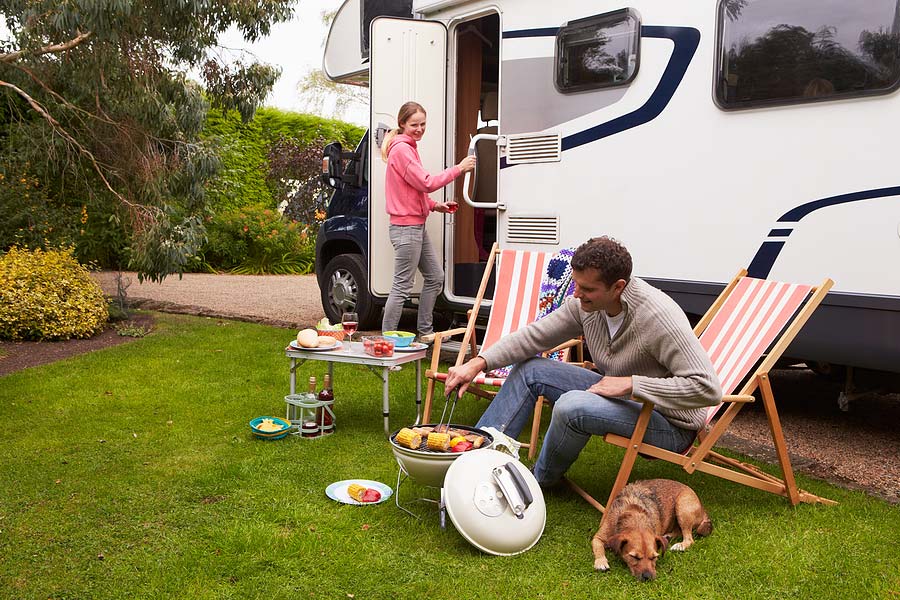Every time I travel, I wish I could bring my cats with me. I’ve been intrigued by stories of friends who successfully take pets on trips in an RV. While I am more of a tent camper, the thought of traveling in a recreational vehicle and being able to bring pets on the road has a certain appeal.
If you are bringing your pets on an RV trip, how can you make sure that the trip is Fear Free, safe, and fun for all? We asked some experts for tips.
Bring a Bit of Home
Familiarity and reminders of home will help pets feel secure on the road, says Crista Coppola, Ph.D., a certified applied animal behaviorist for SeniorTailWaggers.com. Pack a bag with a few of your pet’s favorite blankets, toys, food and water dishes, or special treats. If there’s a daily routine you’ve developed at home with your pet, continue it as much as possible on the road or in a campsite. Keep feeding, walking, and bathroom times similar, too.
Secure Pets While RV Is Moving
Keepings pets safe and secure in a moving RV is critical for everyone’s safety, says RV broker and enthusiast Phil Colonna. He suggests that pets be kept completely away from the front of an RV when it is being driven, using a barrier such as a pet gate. It’s safest for everyone if pets ride in sturdy carriers that are secured so they can’t fall, slip, or roll. They definitely shouldn’t ride in anyone’s lap while the RV is in motion.
Make sure collars can’t catch on anything when pets are inside kennels or carriers. Trim nails beforehand to prevent them from snagging on carpet and causing injury.
When you reach your destination, kennels and cat carriers can provide a secure hiding or resting place for your animals. I have acclimated cats to a new home with the use of a cat carrier, which provide a secure “cave” for animals that prefer this.
Consider Climate
Things can heat up fast in an RV if it’s hot outside, Colonna says. Always be aware of the indoor temperature of the RV and run the air conditioner if needed at rest stops or at your campsite. Some RVs have generators to run air conditioners and allow remote temperature monitoring.
Case the New Locale
You’ve arrived, and the inclination may be to quickly pile out of the RV and explore your new surroundings. Do this first without your animals. Check for dangers. Are you near a drop off or a busy road? Is there an aggressive dog in the next campsite? Are there dangerous things that a dog or cat might be tempted to chew? Just as you would check a hotel room for safety before letting your pet into it for the first time, do the same thing in a new campsite or RV location. A leash is your dog’s (and cat’s) best friend in a new location. Never let your pet roam free while you’re camping. Wild animals are always a danger, and an unfamiliar area may be territory for predators that you’re not used to thinking about at home.
Use ID and Locator Technology
Coppola recommends dog travel tags (similar to what is used on airline suitcases) to clearly indicate that your dog is traveling, with local contact information. “GPS tags are trendy, too: if your dog gets loose but still has his collar on, you can easily track him on your phone.”
Microchip pets ahead of time and have easy and organized access to their chip numbers and the associated registries. Similarly, carry digital and/or paper copies of rabies and other vaccination history for each pet. It’s good to have contact information and hours of area veterinarians and emergency hospitals once you arrive at your destination. Make sure that area veterinarians are accepting new patients or can accommodate an emergency.
Calming Products
There are many options for supporting your pets with a calming supplement while traveling; these can make the trip nicer for everyone. When we moved my cats cross-country, I used pheromones in the car, and gave the cats a calming supplement. The cats did better than the humans on a 1,300-mile drive. A calming supplement such as Zylkene comes in capsule form for both cats and dogs and helps to balance the stress reaction without tranquilizing or sedating effects.
Holiday Considerations
During holidays, all of the above advice applies—and more. Plan for busier roads, for example, and make sure pets are secure in your RV. Reservations for any activities along the way might require more planning and more time. Veterinarians might have reduced hours; find out ahead of time. If you’re traveling in a northern region, pay special attention to snowfall patterns, weather that can change suddenly (in mountains, for example), and road conditions.
Indoors, be aware of the same hazards that might arise at home. Know which foods are not safe for cats and dogs (chocolate, for example). Secure your animals if you’re going to have company coming in and out of the RV – it takes only a moment for a scared pet to dart out and go missing in an unfamiliar place.
Use a bit of common sense and planning, and you can bring your pets on your next RV trip safely and securely.
See you down the road!
This article was reviewed/edited by board-certified veterinary behaviorist Dr. Kenneth Martin and/or veterinary technician specialist in behavior Debbie Martin, LVT.
Catherine Holm is the award-winning author of cat fantasy fiction and cat-themed memoir. She lives in Minnesota with her husband and six well-loved cats. Learn more about her work at www.catherineholm.com.
Brought to you by our friends at









